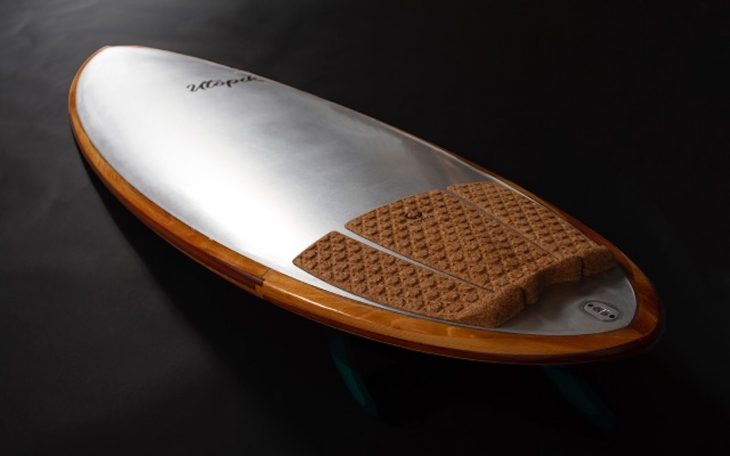By Rose Eaton, Light Metal Age.
Surfing is a widely enjoyed activity all over the world where the sea meets the land. Since the Polynesians brought surfing into Hawaii in the 1800s, the surfboard itself has been constructed of a variety of materials. The main requirements for a sturdy surfboard are that it is lightweight, buoyant, hydrodynamic, shapeable, durable, and more recently, sustainable. Surfboard shapers are beginning to see the environmental benefits of infinitely recyclable boards, enabling aluminum to finally get its day in the sun.
History of Surfing
The lore of walking on water transverses many mythologies, and is today embodied by the sport of surfing. Reports of Polynesians standing on waves were written as far back as 1767 by seafaring Europeans. However, archaeological evidence suggests that Peruvians surfed on watercraft made of reed as far back as five thousand years ago.
Surfing as we know it today was said to have been brought to Hawaii by Polynesian settlers. Its major popularity around the world today can be traced to a demonstration given by Hawaiian diver Duke Kahanamoku on a 1914 visit to Australia after his star-making turn as an Olympic swimmer. Kahanamoku is to surfing what Jimi Hendrix is to electric guitar — considered a legend, a veritable Godfather of surfing.
Surfing is not only a sport, but a way to commune with nature and be one with the rhythm of the earth. Many seek it out for not only its physical benefits but also for its many meditative qualities, including the stress relief that it can provide. There is something Zen about catching a wave in the split second it breaks, being in the right place at the right time, then managing to stand up and balance on a board and glide through water, a rare kind of exhilaration that can only be experienced when in the flow.
Surfers are widely known as environmentalists, desiring to care for the ocean that has undoubtedly provided endless hours of activity for them. Ironically the very tool they have used (surfboards) have taken their own toll on the environment in the last century. In Kahanamoku’s time and for years after, surfboards were made from wood. These boards were about as heavy as a dining room table and one would need a crew of people, or a very strong body and set of wills to drag it across the sand and into the water. There was a major need for a less cumbersome and more aerodynamic board as the activity gained popularity over time.
Surfboard Design
Changes in surfboard design have been steady over the decades, incorporating each era’s materials, ideas and technology as a way to constantly improve the pastime. Surfboard designers discovered ways to make the boards less heavy, more buoyant, and more aerodynamic.
Developments in industrial and manufacturing technology made during World War II extended to the surfboard world in the late 1940s and early 1950s. The most lasting and important development in surfboard design occurred in the late 1950s with the phasing out of wood in favor of fiberglass and polyurethane foam.
Today’s surfboards are mostly made from fiberglass with a polyurethane or polystyrene (polymer) foam core. The fiberglass is covered with a skin of hardened polyester resin. The issue with these polymers is that they are nearly non-recyclable. Most boards end up eventually dumped into a landfill, save for a few of the “lucky” ones that become decorations on pizza parlor walls or tiki-bars.
Broken surfboards abandoned in the ocean or stuck in the seabed are also dangerous, posing threats to marine life who can mistake it for food. If the disposed surfboards don’t end up in a marine mammal’s stomach, eventually they will likely join the island of plastic waste (about the size of Texas) floating in the ocean.
Some epoxy expanded polystrene boards (EPS) are a slight improvement on previous iterations. The company that makes Enviro-foam uses combination of scraps from standard surfboard blanks, as well as styrofoam and other recyclable foams mixed with virgin EPS foam to create the board blanks. There are also grassroots efforts to make surfboards from plant materials, including mycelium, a part of the mushroom. This ‘mycofoam’ is durable and easily decomposes if broken or lost in the ocean.
The search for more environmentally friendly or recyclable surfboards has become more and more popular as surfers become aware of their environmental footprint. Many have joined the quest to go back to the basics and reinvent the wooden board. Ventana Surfboards out of Santa Cruz, CA, have created hollow-framed, reclaimed wooden surfboards. The company has a vision of environmental responsibility and stewardship, and use a wooden spine with ribs design to reduce the weight of the board (versus solid wood), wrapping the body in a final layer of light flexible waterproof wood.
Aluminum in Surfboards
It is a wonder that there haven’t been more attempts to design a surfboard using aluminum, considering its inherent properties such as lightweightness, corrosion resistance, and recyclability.
There have been some art-over-function aluminum creations, including one made of 72 discarded beer cans covered in epoxy resin by artist Rich Morrison. Australian designer Marc Newson also presented a limited edition aluminum board in 2019. The board came in a range of luminescent colors, and big-wave surfer Garrett McNamara even used one to surf one of the most massive waves in the world at Nazaré, Portugal.
In 2015, the company Varial Surf in Ventura, CA, was founded with a vision to engineer and make high performance boards by adapting advanced aerospace materials in their design. At that time they designed a board with an aluminum honeycomb molded core for its structure. There have been many attempts throughout the years to use aluminum materials in different parts of the surfboard, but none that have really come into mainstream usage.
Now, Utopik Aluminum Surfboards out of Brittany, France, is aiming to create, design, and manufacture aluminum sandwich surfboards that can be recycled in a closed loop. According to the company, their bridge-core-hull-box boards will be made of aluminum (with more than 95% recycled content) and wood. The wood is eco-friendly and comes from non-invasive fast-growing trees with a high CO2 absorption rate. Their aluminum boards are currently in the testing/production phase and will be 100% recyclable. Aluminum can be recycled in a closed loop and this operation consumes only 5% of the energy initially required for its production. Also, aluminum recycling capabilities are far further along than any kind of recycling that may be available for polymers at this time.
The idea for Utopik comes from Frédéric Clermont, an industrial designer and surfer who was fed up with having to replace non-recyclable boards every few years. This drove him to begin experimenting with aluminum, using aerospace technology. He successfully tested his aluminum honeycomb surfboard in January 2019, and Utopik took third place at France’s Nina Awards for nautical innovation in the same year.
Once Clermont came up with a prototype, he launched a crowdfunding campaign and raised his goal of €4,000 in January 2020, which he says will go towards serial production of his first model. In the future, the Breton designer hopes to apply the same technology to more watersports gear.
“A pioneer in this technology in the field of nautical sports, our medium-term project is to extend our field of action to the worlds of paddle, kitesurf, and windsurf [boards] by transposing our industrial process on these supports and become a capable company to offer innovative and recyclable products, favoring eco-design, ecological, and/or recycled materials, short circuits, and the circular economy.”
Clermont and other sustainability pioneers in the world of surfing may just be on to something. The future of surfing is ready for a sea change.




